University Civil Law Assignment: Property, Consumer, and Negligence
VerifiedAdded on 2022/12/15
|6
|1157
|465
Homework Assignment
AI Summary
This Civil Law assignment addresses several key areas of law, including property law, consumer law, and negligence. The first question analyzes the conditions for land sales under the Conveyancing Act 1919 and Real Property Act 1900, covering purchaser rights and vendor obligations. The second question examines a case involving a real estate agent's misconduct and potential breaches of the Australian Consumer Law, specifically regarding commission and agent responsibilities. The third question explores negligence in a car park scenario, evaluating liability for property damage and the application of consumer protection guidelines. Finally, the fourth question delves into misrepresentation by real estate agents and its impact on a purchaser's ability to build their desired property, referencing the Hyder v McGrath case to determine causation of damages. The assignment uses relevant legislation and case law to support its arguments.
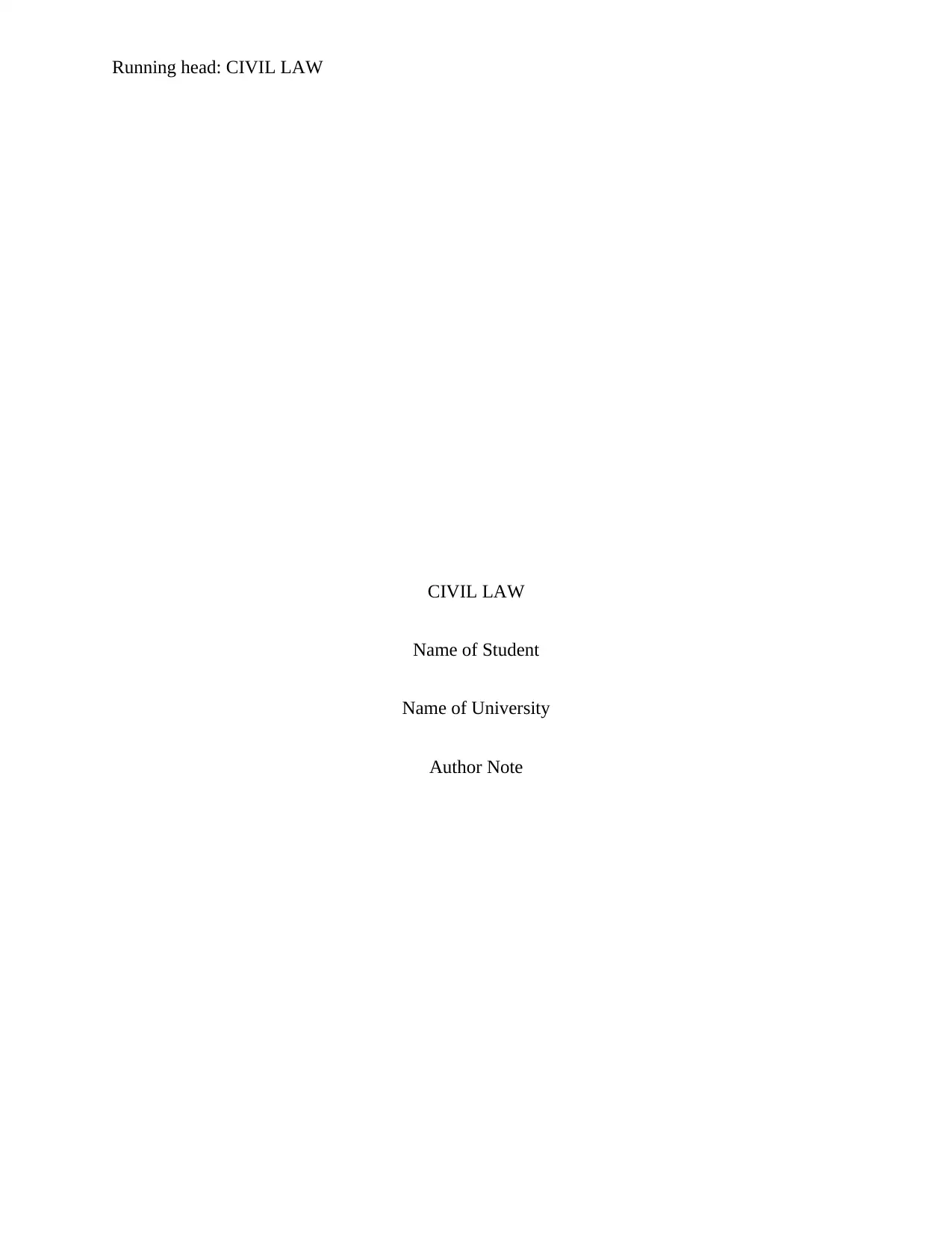
Running head: CIVIL LAW
CIVIL LAW
Name of Student
Name of University
Author Note
CIVIL LAW
Name of Student
Name of University
Author Note
Paraphrase This Document
Need a fresh take? Get an instant paraphrase of this document with our AI Paraphraser
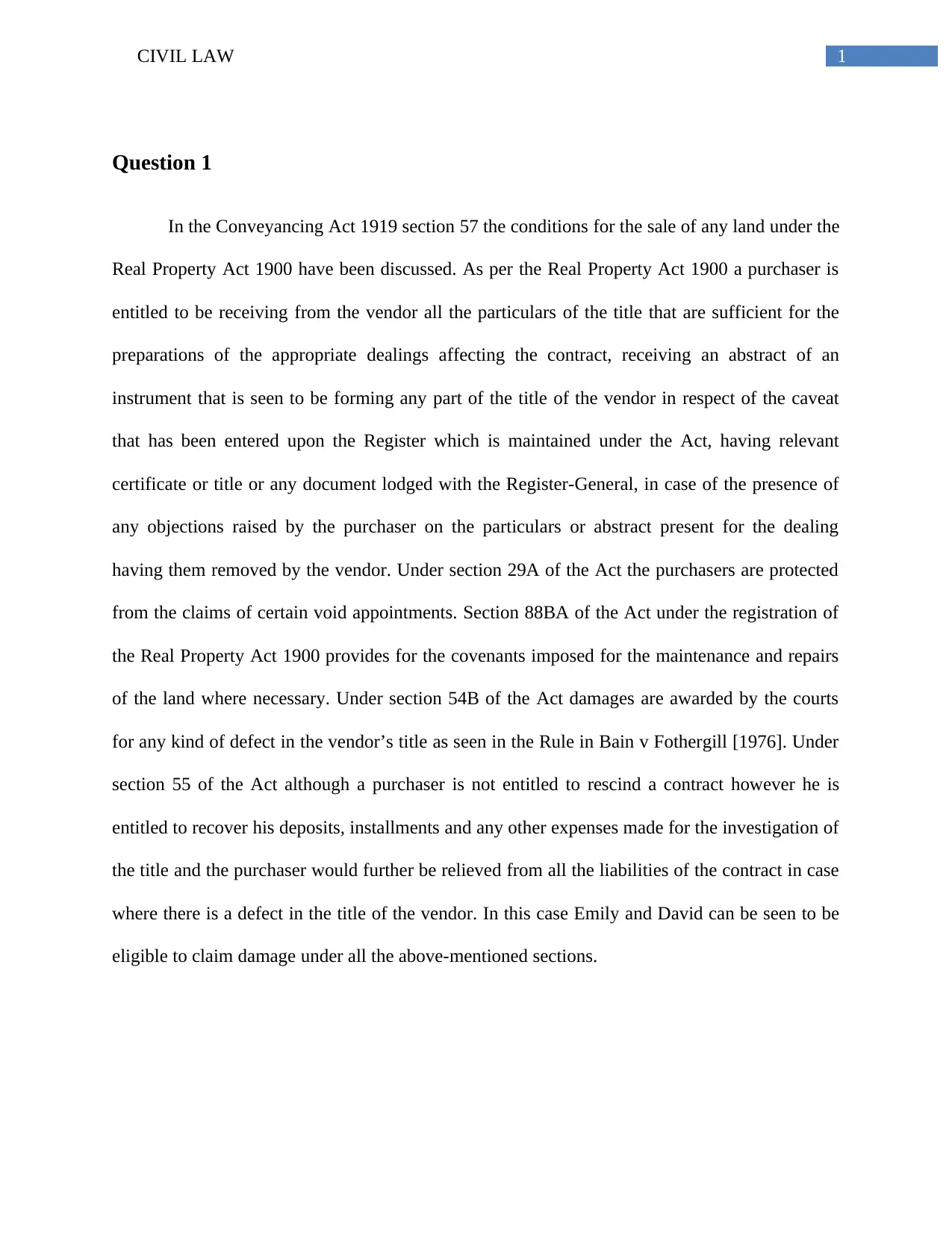
1CIVIL LAW
Question 1
In the Conveyancing Act 1919 section 57 the conditions for the sale of any land under the
Real Property Act 1900 have been discussed. As per the Real Property Act 1900 a purchaser is
entitled to be receiving from the vendor all the particulars of the title that are sufficient for the
preparations of the appropriate dealings affecting the contract, receiving an abstract of an
instrument that is seen to be forming any part of the title of the vendor in respect of the caveat
that has been entered upon the Register which is maintained under the Act, having relevant
certificate or title or any document lodged with the Register-General, in case of the presence of
any objections raised by the purchaser on the particulars or abstract present for the dealing
having them removed by the vendor. Under section 29A of the Act the purchasers are protected
from the claims of certain void appointments. Section 88BA of the Act under the registration of
the Real Property Act 1900 provides for the covenants imposed for the maintenance and repairs
of the land where necessary. Under section 54B of the Act damages are awarded by the courts
for any kind of defect in the vendor’s title as seen in the Rule in Bain v Fothergill [1976]. Under
section 55 of the Act although a purchaser is not entitled to rescind a contract however he is
entitled to recover his deposits, installments and any other expenses made for the investigation of
the title and the purchaser would further be relieved from all the liabilities of the contract in case
where there is a defect in the title of the vendor. In this case Emily and David can be seen to be
eligible to claim damage under all the above-mentioned sections.
Question 1
In the Conveyancing Act 1919 section 57 the conditions for the sale of any land under the
Real Property Act 1900 have been discussed. As per the Real Property Act 1900 a purchaser is
entitled to be receiving from the vendor all the particulars of the title that are sufficient for the
preparations of the appropriate dealings affecting the contract, receiving an abstract of an
instrument that is seen to be forming any part of the title of the vendor in respect of the caveat
that has been entered upon the Register which is maintained under the Act, having relevant
certificate or title or any document lodged with the Register-General, in case of the presence of
any objections raised by the purchaser on the particulars or abstract present for the dealing
having them removed by the vendor. Under section 29A of the Act the purchasers are protected
from the claims of certain void appointments. Section 88BA of the Act under the registration of
the Real Property Act 1900 provides for the covenants imposed for the maintenance and repairs
of the land where necessary. Under section 54B of the Act damages are awarded by the courts
for any kind of defect in the vendor’s title as seen in the Rule in Bain v Fothergill [1976]. Under
section 55 of the Act although a purchaser is not entitled to rescind a contract however he is
entitled to recover his deposits, installments and any other expenses made for the investigation of
the title and the purchaser would further be relieved from all the liabilities of the contract in case
where there is a defect in the title of the vendor. In this case Emily and David can be seen to be
eligible to claim damage under all the above-mentioned sections.
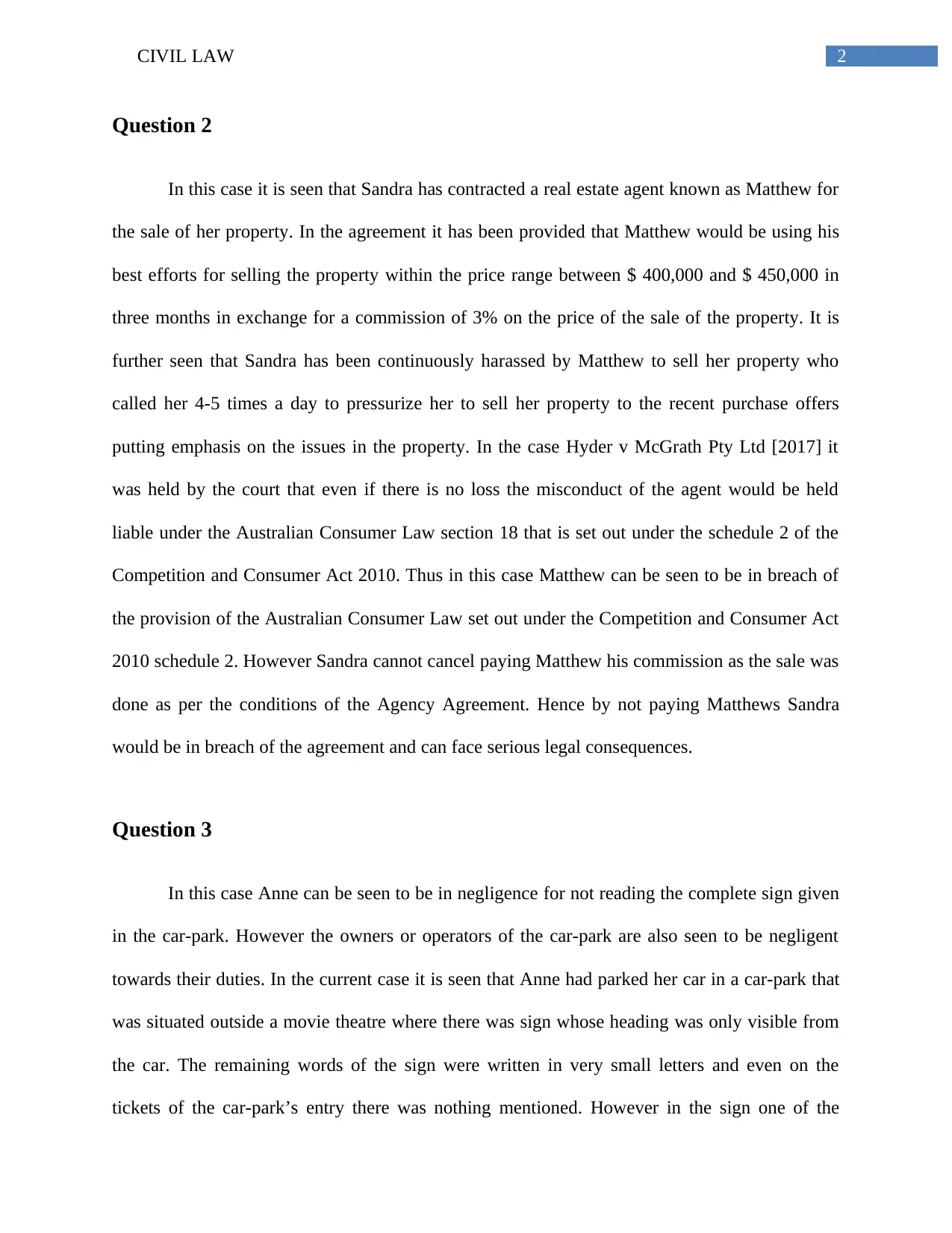
2CIVIL LAW
Question 2
In this case it is seen that Sandra has contracted a real estate agent known as Matthew for
the sale of her property. In the agreement it has been provided that Matthew would be using his
best efforts for selling the property within the price range between $ 400,000 and $ 450,000 in
three months in exchange for a commission of 3% on the price of the sale of the property. It is
further seen that Sandra has been continuously harassed by Matthew to sell her property who
called her 4-5 times a day to pressurize her to sell her property to the recent purchase offers
putting emphasis on the issues in the property. In the case Hyder v McGrath Pty Ltd [2017] it
was held by the court that even if there is no loss the misconduct of the agent would be held
liable under the Australian Consumer Law section 18 that is set out under the schedule 2 of the
Competition and Consumer Act 2010. Thus in this case Matthew can be seen to be in breach of
the provision of the Australian Consumer Law set out under the Competition and Consumer Act
2010 schedule 2. However Sandra cannot cancel paying Matthew his commission as the sale was
done as per the conditions of the Agency Agreement. Hence by not paying Matthews Sandra
would be in breach of the agreement and can face serious legal consequences.
Question 3
In this case Anne can be seen to be in negligence for not reading the complete sign given
in the car-park. However the owners or operators of the car-park are also seen to be negligent
towards their duties. In the current case it is seen that Anne had parked her car in a car-park that
was situated outside a movie theatre where there was sign whose heading was only visible from
the car. The remaining words of the sign were written in very small letters and even on the
tickets of the car-park’s entry there was nothing mentioned. However in the sign one of the
Question 2
In this case it is seen that Sandra has contracted a real estate agent known as Matthew for
the sale of her property. In the agreement it has been provided that Matthew would be using his
best efforts for selling the property within the price range between $ 400,000 and $ 450,000 in
three months in exchange for a commission of 3% on the price of the sale of the property. It is
further seen that Sandra has been continuously harassed by Matthew to sell her property who
called her 4-5 times a day to pressurize her to sell her property to the recent purchase offers
putting emphasis on the issues in the property. In the case Hyder v McGrath Pty Ltd [2017] it
was held by the court that even if there is no loss the misconduct of the agent would be held
liable under the Australian Consumer Law section 18 that is set out under the schedule 2 of the
Competition and Consumer Act 2010. Thus in this case Matthew can be seen to be in breach of
the provision of the Australian Consumer Law set out under the Competition and Consumer Act
2010 schedule 2. However Sandra cannot cancel paying Matthew his commission as the sale was
done as per the conditions of the Agency Agreement. Hence by not paying Matthews Sandra
would be in breach of the agreement and can face serious legal consequences.
Question 3
In this case Anne can be seen to be in negligence for not reading the complete sign given
in the car-park. However the owners or operators of the car-park are also seen to be negligent
towards their duties. In the current case it is seen that Anne had parked her car in a car-park that
was situated outside a movie theatre where there was sign whose heading was only visible from
the car. The remaining words of the sign were written in very small letters and even on the
tickets of the car-park’s entry there was nothing mentioned. However in the sign one of the
⊘ This is a preview!⊘
Do you want full access?
Subscribe today to unlock all pages.

Trusted by 1+ million students worldwide
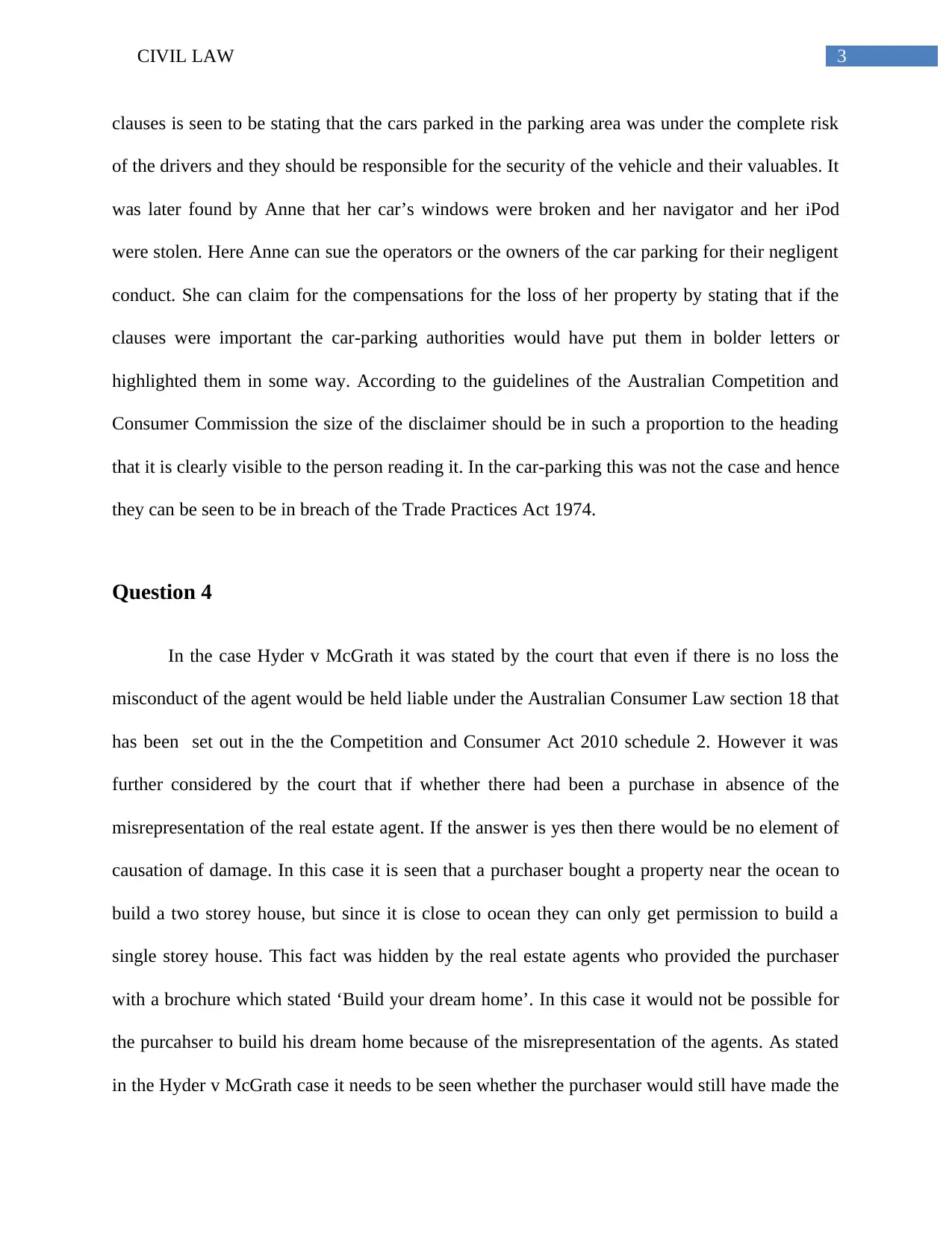
3CIVIL LAW
clauses is seen to be stating that the cars parked in the parking area was under the complete risk
of the drivers and they should be responsible for the security of the vehicle and their valuables. It
was later found by Anne that her car’s windows were broken and her navigator and her iPod
were stolen. Here Anne can sue the operators or the owners of the car parking for their negligent
conduct. She can claim for the compensations for the loss of her property by stating that if the
clauses were important the car-parking authorities would have put them in bolder letters or
highlighted them in some way. According to the guidelines of the Australian Competition and
Consumer Commission the size of the disclaimer should be in such a proportion to the heading
that it is clearly visible to the person reading it. In the car-parking this was not the case and hence
they can be seen to be in breach of the Trade Practices Act 1974.
Question 4
In the case Hyder v McGrath it was stated by the court that even if there is no loss the
misconduct of the agent would be held liable under the Australian Consumer Law section 18 that
has been set out in the the Competition and Consumer Act 2010 schedule 2. However it was
further considered by the court that if whether there had been a purchase in absence of the
misrepresentation of the real estate agent. If the answer is yes then there would be no element of
causation of damage. In this case it is seen that a purchaser bought a property near the ocean to
build a two storey house, but since it is close to ocean they can only get permission to build a
single storey house. This fact was hidden by the real estate agents who provided the purchaser
with a brochure which stated ‘Build your dream home’. In this case it would not be possible for
the purcahser to build his dream home because of the misrepresentation of the agents. As stated
in the Hyder v McGrath case it needs to be seen whether the purchaser would still have made the
clauses is seen to be stating that the cars parked in the parking area was under the complete risk
of the drivers and they should be responsible for the security of the vehicle and their valuables. It
was later found by Anne that her car’s windows were broken and her navigator and her iPod
were stolen. Here Anne can sue the operators or the owners of the car parking for their negligent
conduct. She can claim for the compensations for the loss of her property by stating that if the
clauses were important the car-parking authorities would have put them in bolder letters or
highlighted them in some way. According to the guidelines of the Australian Competition and
Consumer Commission the size of the disclaimer should be in such a proportion to the heading
that it is clearly visible to the person reading it. In the car-parking this was not the case and hence
they can be seen to be in breach of the Trade Practices Act 1974.
Question 4
In the case Hyder v McGrath it was stated by the court that even if there is no loss the
misconduct of the agent would be held liable under the Australian Consumer Law section 18 that
has been set out in the the Competition and Consumer Act 2010 schedule 2. However it was
further considered by the court that if whether there had been a purchase in absence of the
misrepresentation of the real estate agent. If the answer is yes then there would be no element of
causation of damage. In this case it is seen that a purchaser bought a property near the ocean to
build a two storey house, but since it is close to ocean they can only get permission to build a
single storey house. This fact was hidden by the real estate agents who provided the purchaser
with a brochure which stated ‘Build your dream home’. In this case it would not be possible for
the purcahser to build his dream home because of the misrepresentation of the agents. As stated
in the Hyder v McGrath case it needs to be seen whether the purchaser would still have made the
Paraphrase This Document
Need a fresh take? Get an instant paraphrase of this document with our AI Paraphraser
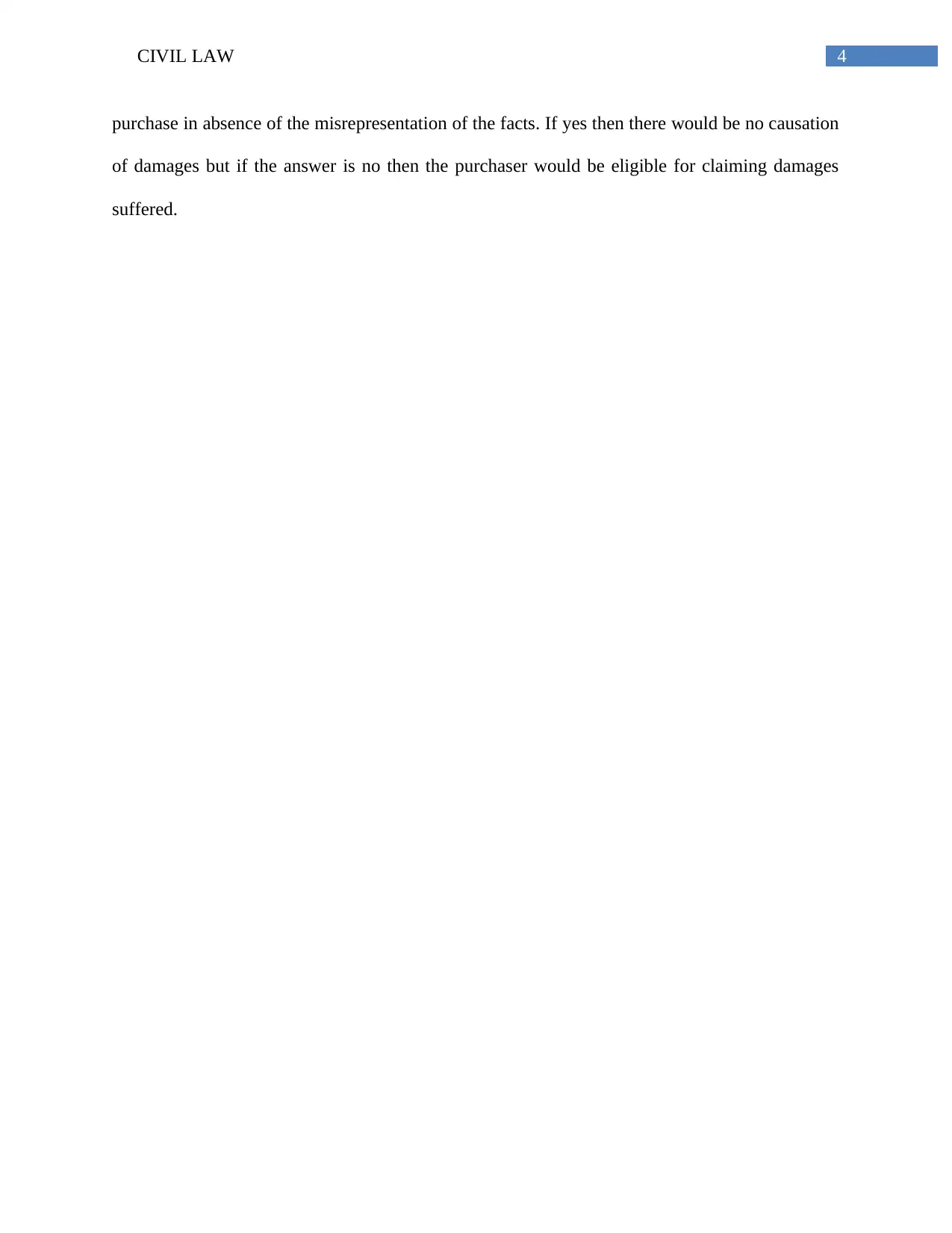
4CIVIL LAW
purchase in absence of the misrepresentation of the facts. If yes then there would be no causation
of damages but if the answer is no then the purchaser would be eligible for claiming damages
suffered.
purchase in absence of the misrepresentation of the facts. If yes then there would be no causation
of damages but if the answer is no then the purchaser would be eligible for claiming damages
suffered.
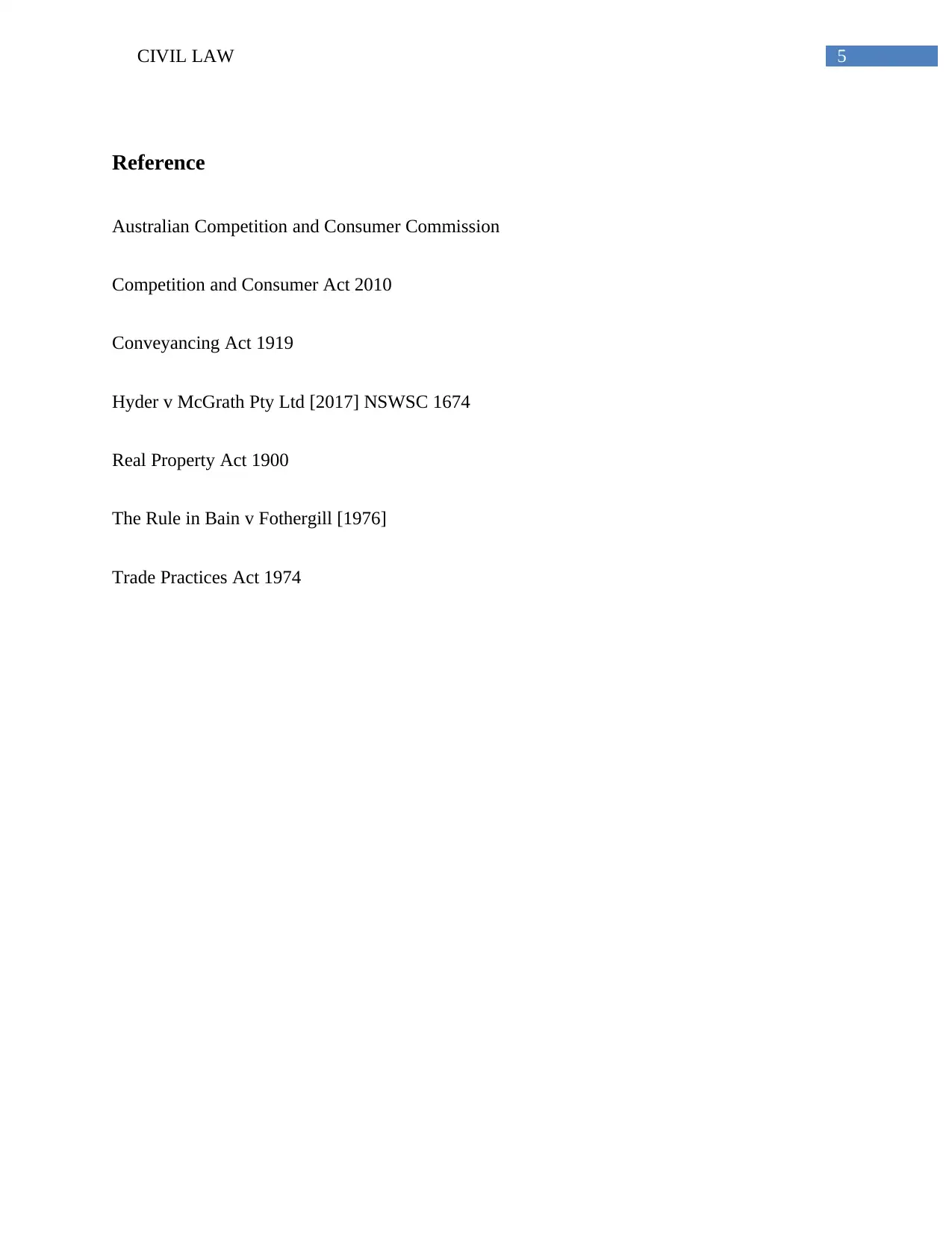
5CIVIL LAW
Reference
Australian Competition and Consumer Commission
Competition and Consumer Act 2010
Conveyancing Act 1919
Hyder v McGrath Pty Ltd [2017] NSWSC 1674
Real Property Act 1900
The Rule in Bain v Fothergill [1976]
Trade Practices Act 1974
Reference
Australian Competition and Consumer Commission
Competition and Consumer Act 2010
Conveyancing Act 1919
Hyder v McGrath Pty Ltd [2017] NSWSC 1674
Real Property Act 1900
The Rule in Bain v Fothergill [1976]
Trade Practices Act 1974
⊘ This is a preview!⊘
Do you want full access?
Subscribe today to unlock all pages.

Trusted by 1+ million students worldwide
1 out of 6
Related Documents
Your All-in-One AI-Powered Toolkit for Academic Success.
+13062052269
info@desklib.com
Available 24*7 on WhatsApp / Email
![[object Object]](/_next/static/media/star-bottom.7253800d.svg)
Unlock your academic potential
Copyright © 2020–2025 A2Z Services. All Rights Reserved. Developed and managed by ZUCOL.





